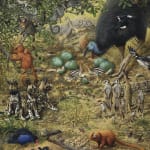 Booth C11
THURSDAY AND FRIDAY 12–8 PM | SATURDAY 12–7 PM | SUNDAY 12–5 PM
Booth C11
THURSDAY AND FRIDAY 12–8 PM | SATURDAY 12–7 PM | SUNDAY 12–5 PM
Hosfelt Gallery presents a solo booth of new paintings by San Francisco Bay Area artist Isabella Kirkland. Self-taught in the meticulous and time-consuming techniques developed by 17th century Dutch painters, Kirkland directs her technical proficiency and rarefied access to biological specimen collections and scientific experts towards illuminating the ecological instability inherent in the Anthropocene — and more specifically, the acute threat to Earth’s smallest creatures.
In the world of environmental activism and nature documentaries, much attention is given to the large, majestic animals facing habitat loss and extinction as a result of sea level rise, ocean warming and acidification, human encroachment and climate change. Kirkland instead turns her focus to the more minute organisms that tend to go unnoticed, but that make up the majority of the natural world. Though seemingly insignificant, the decline of any of these tiny creatures instigates a domino effect of ecological disruption and potential collapse.
Kirkland purposefully chooses archaic methods to convey an urgently topical message. Her mode of depiction is an adaptation of the still life genre and 19th century natural history illustration — traditions revered for their accurate depictions of flora and fauna before the advent of photography. Executed in the enduring technique of the Dutch masters, Kirkland’s paintings enable a form of physical preservation of species that may otherwise soon disappear forever.
Several works in the presentation document some of the 5.5 million butterflies at the African Butterfly Research Institute (ABRI), an organization based in Kenya and run by a single individual. The collection is comprised of about 4.5 million pinned, labeled specimens in boxes, sorted by genus, species, and locality, with another million unpinned and frozen, so that the DNA can be analyzed. The fate of this priceless repository of lepidopteric heritage remains precarious, and a campaign is underway to fund their efforts to donate the collection to one or more institutions that can ensure its long-term preservation.
Isabella Kirkland was born in Connecticut in 1954 and studied at the San Francisco Art Institute in the late 1970s. Her work is in major museum collections throughout the United States, including the Berkeley Art Museum (Berkeley, CA), San Francisco Museum of Modern Art, Hammer Museum (Los Angeles), St. Louis Museum of Art, The Hood Museum of Art (Hanover, NH), Pennsylvania Academy of Fine Arts (Philadelphia), Yale University Art Gallery (New Haven, CT), Queens Museum (New York), Tang Museum (Saratoga Springs, NY), Toledo Art Museum (OH), Zimmerli Art Museum (New Brunswick, NJ), and the Whitney Museum of American Art (New York).

